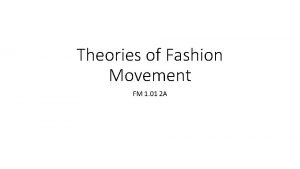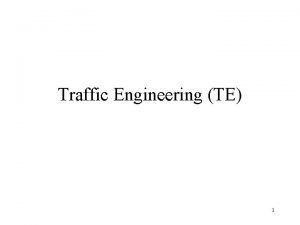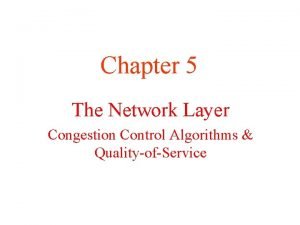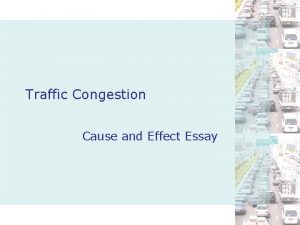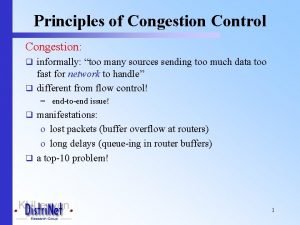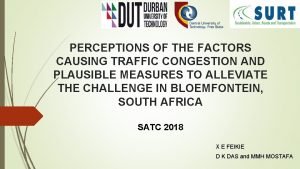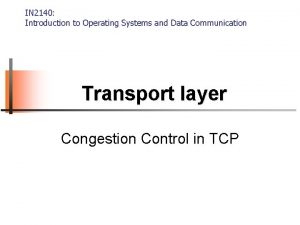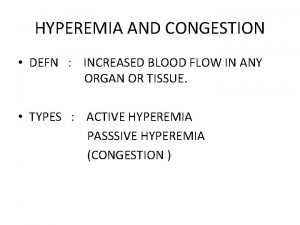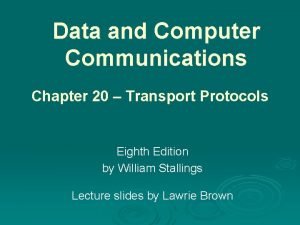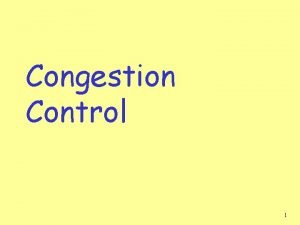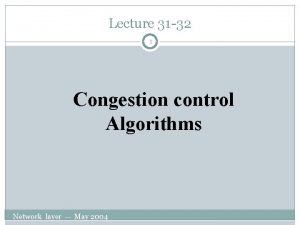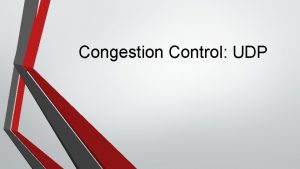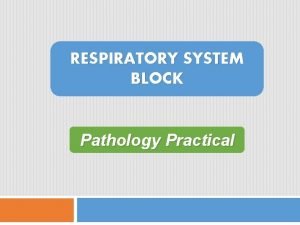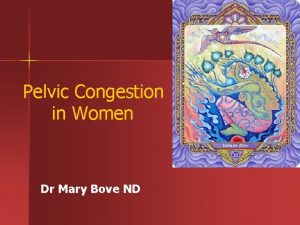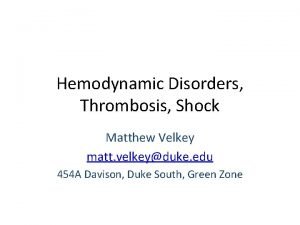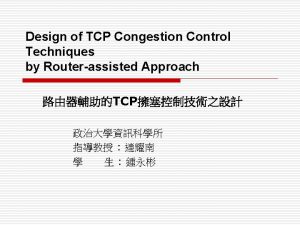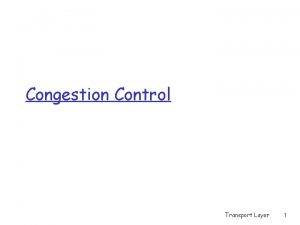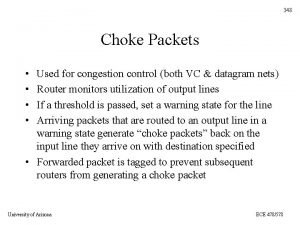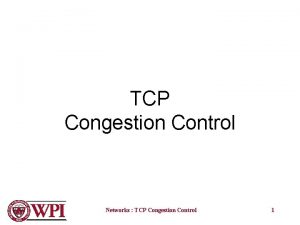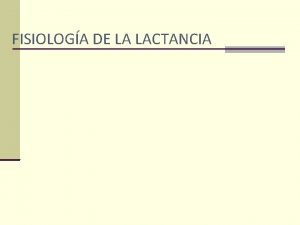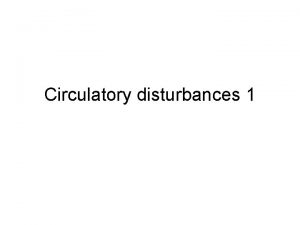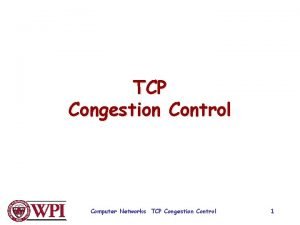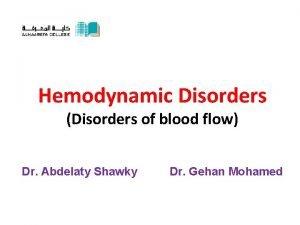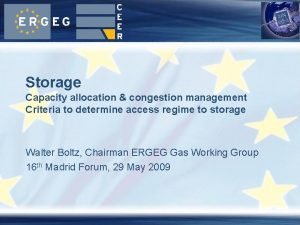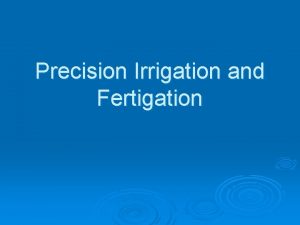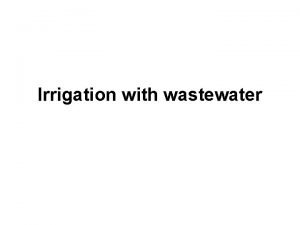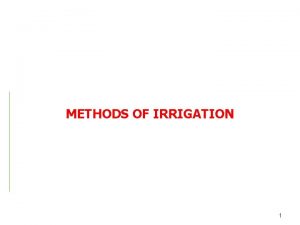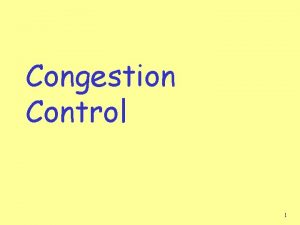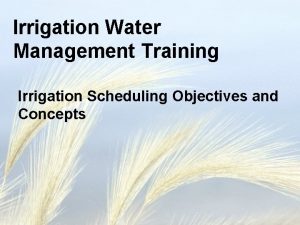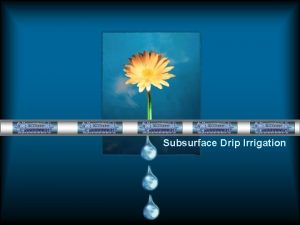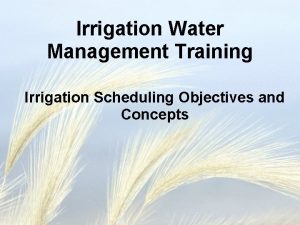Trickle Irrigation Congestion Relief for Communication with Network
























![Simulation Setup (1) Implement FUN-1, FUN-2 [1], a BATS code [2], a fountain code Simulation Setup (1) Implement FUN-1, FUN-2 [1], a BATS code [2], a fountain code](https://slidetodoc.com/presentation_image_h2/efddc0480cc07bddc4dced5bf7d38f43/image-25.jpg)











- Slides: 36

Trickle Irrigation: Congestion Relief for Communication with Network Coding: where Shannon Meets Lyapunov Dapeng Oliver Wu Department of Electrical and Computer Engineering University of Florida Joint work with Qiuyuan Huang, Jiade Li, Yun Zhu

Outline Motivation Trickle and related work architecture and overview Description of Trickle and stability analysis Experimental results Conclusions 2

Error Control for Communication over Lossy Channels Forward Error Correction (FEC) Channel coding with fixed code rate: RS code, LDPC, Turbo codes Rateless codes: fountain codes, LT codes, Raptor codes Automatic Repeat re. Quest (ARQ): TCP Network coding: BATS codes, FUN-1, FUN-2 codes, RLNC 3

Congestion Control for Communication Networks TCP Network Utility Maximization (NUM) Use nonlinear programming techniques to solve NUM problems Primal/dual/primal-dual algorithms TCP is an online distributed algorithm that solves an NUM problem Stochastic NUM with fading channels/interference channels/random channel contention Lyapunov drift (queue stability) Lyapunov optimization (stable queue with optimal cost) 4

Unconsummated Union of Information Theory (Shannon) and Congestion Control Theory (Lyapunov) Information theory studies reliable transmission and channel coding, with no consideration of congestion control Congestion control theory: theory of controlled queues Control the source rate at each end host Control the transmission of each router Joint study of information theory and congestion control theory, opens up a brand new research direction Our goal is to develop congestion control techniques, well suited for network coding. 5

Back-pressure-based Congestion Control for Wireless Networks For one flow, a downstream node creates a token to its upstream node when the downstream node finishes transmitting one packet. For multiple flow and multiple nodes competing for channel access, only the node having a flow with maximum differential queue is allowed to transmit a packet of the flow with maximum differential queue. Why it is called “back pressure”? Data plane vs. control plane: The direction of control signal flow is opposite to the direction of data flow The upstream node has a higher potential than the downstream node; the potential difference creates the force to push the transmission of packets from the upstream node to the downstream node. Hence it is called back pressure. An upstream node is allowed to transmit to (or push) the downstream node, only when it has largest force (largest potential difference) 6

Types of Back Pressure (BP) Congestion Control Per destination based BP congestion control Per link based BP congestion control 7

Per-destination-based BP Congestion Control Per-destination (PD) queueing structure: In PD queueing networks, every node needs to maintain a queue for each destination. Global approach Pros: throughput optimal (achieving network capacity) Cons: not scalable; the number of queues maintained in each node is equal to the number of nodes in the network 8

Per-link-based BP Congestion Control Per-link (PL) queueing structure: In PL queueing networks, every node needs to maintain a queue for each of its neighboring nodes. Local approach Pros: scalable; the number of queues maintained in each node is equal to the number of its neighboring nodes Cons: not suitable for congestion control with network coding 9

Our Solution: Trickle Architecture and Control Trickle is a lightweight, back-pressure based congestion control scheme, custom-designed for network coding 10

Overview of Trickle architecture Each node maintains multiple TRiple-node Indexed (TRI) queues Each TRI queue buffers packets going through (parent, node, child) triple-nodes Can be easily tailored for network coding TRI queues are dynamically created Queue length information exchanged by piggybacking MAC layer is based on IEEE 802. 11 e Source rate control in place 11

Input Model for TRI Queue 12

Output Model for TRI Queue 13

Notations: 14

Network model Bounded arrival rates 15

Updating Rule of TRI Queues 16

Trickle Scheduling Algorithm 17

Trickle Scheduling Algorithm is Throughput Optimal 18

Source Rate Control (AIMD) Dynamically adjust sending rate according to queue length. Queue length high-threshold: multiplicative decrease Queue length low-threshold: additive increase 19

Trickle Implementation Basic TRI queue structure – (parent, child) 20

Trickle Implementation For network-coded packets: Set aside an additional virtual queue -- essentially a counter, which help track the flow information for mixed packets. When one mixed packet put in a TRI queue, we count it twice. 21

Queue Info. Exchange In order to save overhead of retrieving this information, we develop an overhearing mechanism where each node can eavesdrop its neighbors for the needed queueing information. An extra header structure after Ethernet header in the data packet. 22

Trickle Header Structure 23

802. 11 e Access Category Prioritized MAC according to ACs 24
![Simulation Setup 1 Implement FUN1 FUN2 1 a BATS code 2 a fountain code Simulation Setup (1) Implement FUN-1, FUN-2 [1], a BATS code [2], a fountain code](https://slidetodoc.com/presentation_image_h2/efddc0480cc07bddc4dced5bf7d38f43/image-25.jpg)
Simulation Setup (1) Implement FUN-1, FUN-2 [1], a BATS code [2], a fountain code (specifically, the RQ code [3]), random linear network code (RLNC) [4], and COPE [5] on Qual. Net. Then, we also implement the proposed Trickle algorithm on MAC layer for each of above coding schemes. [1] Q. Huang, K. Sun, X. Li, and D. Wu, “Just fun: A joint fountain coding and network coding approach to loss-tolerant information spreading, ” in Proceedings of ACM Mobi. Hoc, 2014. [2] S. Yang and R. W. Yeung, “Batched sparse codes, ” submitted to IEEE Transactions on Information Theory. [3] A. Shokrollahi and M. Luby, “Raptor codes, ” Foundations and Trends in Communications and Information Theory, vol. 6, no. 3– 4, pp. 213– 322, 2011. [Online]. Available: http: //dx. doi. org/10. 1561/0100000060 [4] M. Wang and B. Li, “Lava: A reality check of network coding in peerto-peer live streaming, ” in IEEE INFOCOM 2007, pp. 1082– 1090. [5] S. Katti, H. Rahul, W. Hu, D. Katabi, M. Medard, and J. Crowcroft, ´ “Xors in the air: practical wireless network coding, ” in ACM SIGCOMM Computer Communication Review, vol. 36, no. 4, 2006, pp. 243– 254. 25

Simulation Setup (2) All the experiments have the following setting: the packet size 1024 bytes; the batch size 16 packets; Trickle queue size is 150 kilobytes, which replaces the layer 3 output queue; source rate control is enabled. The time-up threshold is set to 30 milliseconds. 26

Network Topologies used in the Simulations Cross topology in both lossless and lossy conditions Chain topology with various number of hops under fixed packet loss rate (10%) per hop. Chain topology 27

Effects of Busyness Ratio on Throughput (1) Busyness ratio: the fraction of a constant time unit (e. g. , one second) in which the channel is in non-idle state. Busyness ratio is considered to be a criterion for measuring channel congestion conditions Conducted in cross topology. 28

Effects of Busyness Ratio on Throughput (2) 29

Effects of Busyness Ratio on Throughput (3) 30

Effects of Packet Loss Ratio on Throughput Performance Conducted under lossy conditions Still use cross topology 31

Effects of Packet Loss Ratio on Throughput Performance 32

Effects of Number of Hops on Throughput Performance Chain topology 3 and 5 hops 3 hops: 5 hops: 33

Effects of Number of Hops on Throughput Performance 34

Conclusions This work is concerned with designing an MAC protocol for network coding, under lossy channel conditions. Although network coding schemes such as BATS and FUN codes are effective mechanisms for communication over lossy channels, they only deal with error control but do not have congestion control capability. To address their limitations, we proposed Trickle -- a novel back-pressure-based MAC scheduling algorithm; it maintains TRI queues at each node, which significantly reduces the number of queues and is scalable for large networks. Our experimental results have shown that Trickle achieves much higher throughput than existing schemes. 35

Thank you! 36
 Circumciliary congestion and conjunctival congestion
Circumciliary congestion and conjunctival congestion Downward flow theory
Downward flow theory Network congestion causes
Network congestion causes Traffic throttling and load shedding
Traffic throttling and load shedding Congestion control in network layer
Congestion control in network layer Traffic congestion essay introduction
Traffic congestion essay introduction General principles of congestion control
General principles of congestion control Conclusion of traffic congestion
Conclusion of traffic congestion Tcp congestion control
Tcp congestion control Difference between hyperemia and congestion
Difference between hyperemia and congestion Tcp congestion control
Tcp congestion control What are the general principles of congestion control
What are the general principles of congestion control Congestion control principles
Congestion control principles Spiroketosis
Spiroketosis Congestion control in virtual circuit
Congestion control in virtual circuit Udp congestion control
Udp congestion control Barrel chest with emphysema
Barrel chest with emphysema Carmen bove
Carmen bove Heart failure cells are seen in lungs
Heart failure cells are seen in lungs Tcp flow control
Tcp flow control Principles of congestion control
Principles of congestion control Choke packet in computer network
Choke packet in computer network Size of tcp segment header
Size of tcp segment header Congestion
Congestion Pletora mamaria
Pletora mamaria Catarrhal appendicitis
Catarrhal appendicitis Chronic passive congestion of liver
Chronic passive congestion of liver General principles of congestion control
General principles of congestion control Circumcorneal congestion
Circumcorneal congestion Hemodynamic disorders
Hemodynamic disorders Capacity allocation and congestion management
Capacity allocation and congestion management Kontinuitetshantering i praktiken
Kontinuitetshantering i praktiken Typiska drag för en novell
Typiska drag för en novell Nationell inriktning för artificiell intelligens
Nationell inriktning för artificiell intelligens Returpilarna
Returpilarna Shingelfrisyren
Shingelfrisyren En lathund för arbete med kontinuitetshantering
En lathund för arbete med kontinuitetshantering

